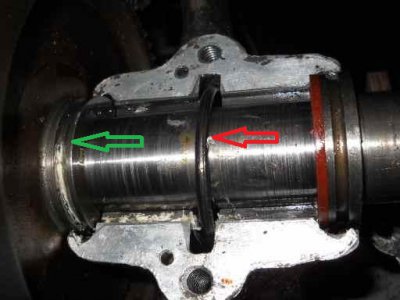- Joined
- Dec 5, 2017
- Messages
- 464
I've got about 3.5 to 4 thousandths runout at the spindle, measured as close to the bearing as I can get.
I realize that's not horrible for a 100+ year old lathe, but it's a rainy day and I felt like puttering, so I decided to have a look at it.
Popped the bearing cap off and see this:

Question 1: Is the ring next to the red arrow supposed to be in the groove on the spindle next to the green arrow? At the moment, it's just flopping around on the shaft. Pretty sure that isn't right.
Question 2: How should I check for play in the shaft? Just grabbing the chuck and trying to move it vertically or laterally doesn't indicate any perceptible play. There are shims under the cap that may well have been there since the lathe was built.
Question 3: What should I lube the spindle with when reassembling?
I realize that's not horrible for a 100+ year old lathe, but it's a rainy day and I felt like puttering, so I decided to have a look at it.
Popped the bearing cap off and see this:

Question 1: Is the ring next to the red arrow supposed to be in the groove on the spindle next to the green arrow? At the moment, it's just flopping around on the shaft. Pretty sure that isn't right.
Question 2: How should I check for play in the shaft? Just grabbing the chuck and trying to move it vertically or laterally doesn't indicate any perceptible play. There are shims under the cap that may well have been there since the lathe was built.
Question 3: What should I lube the spindle with when reassembling?


